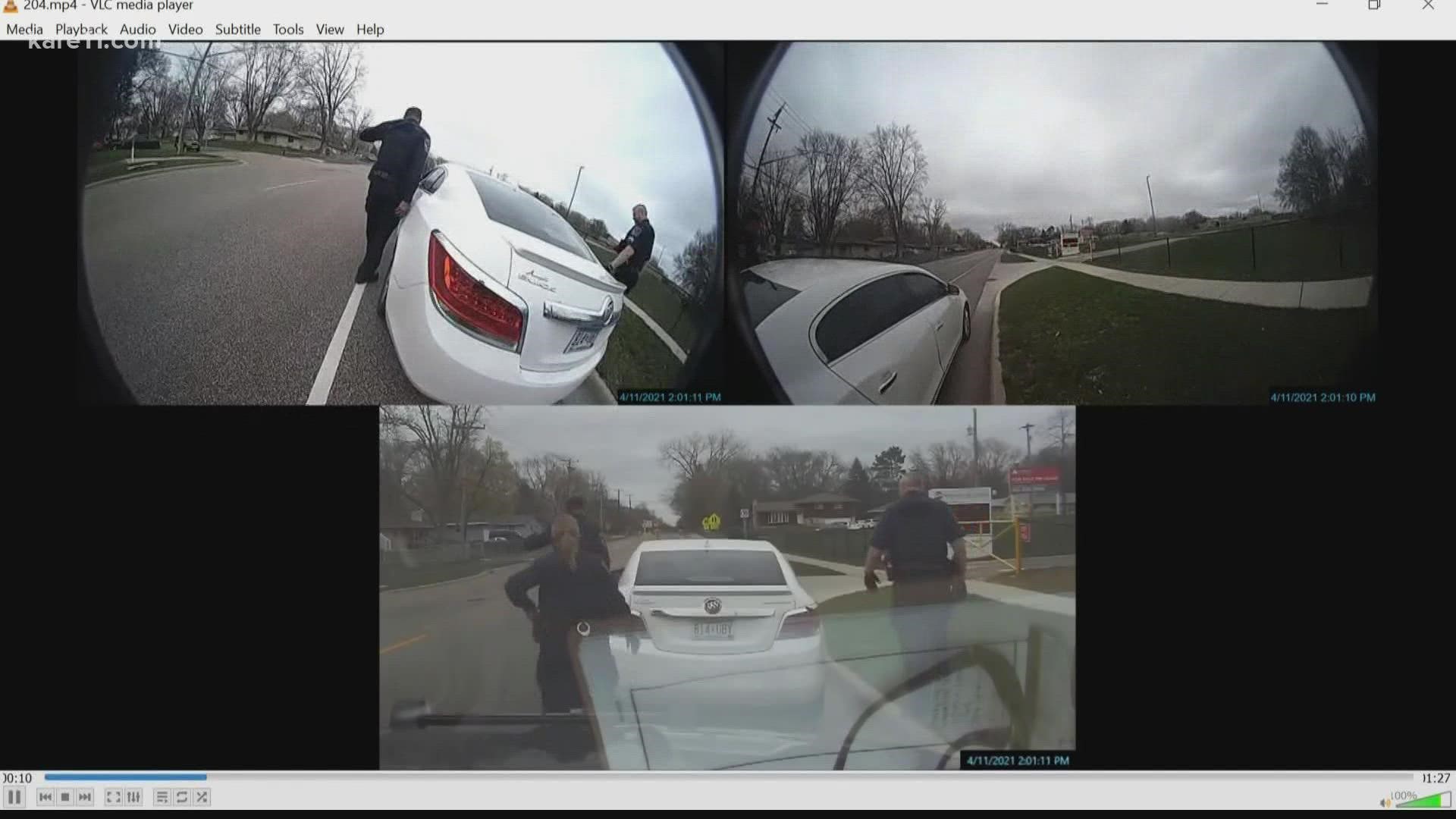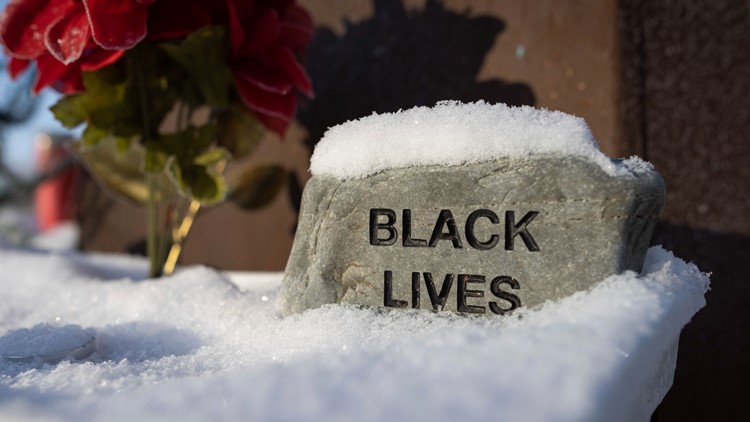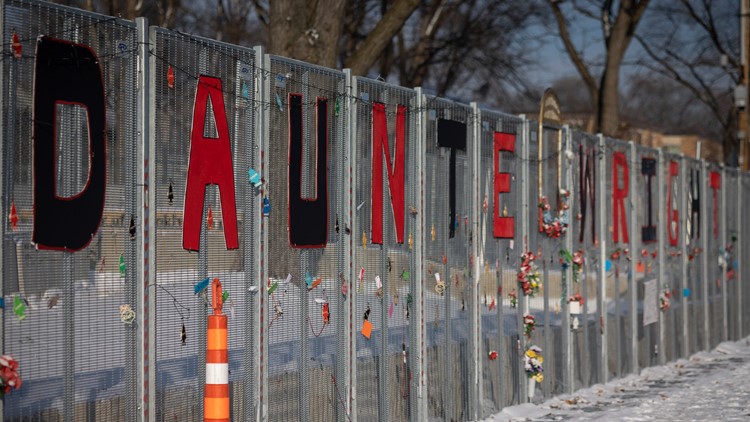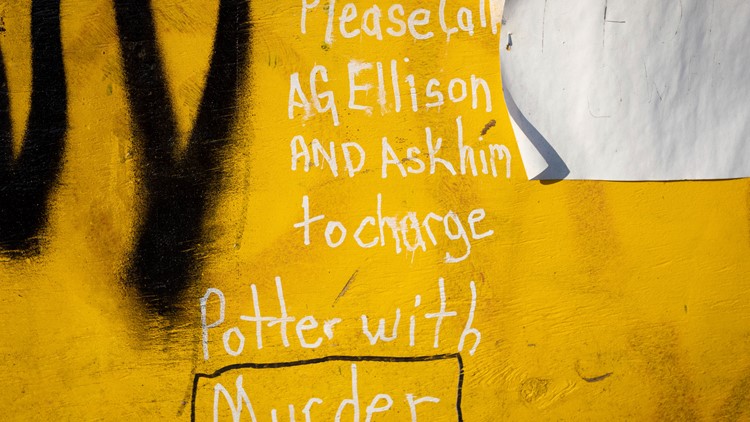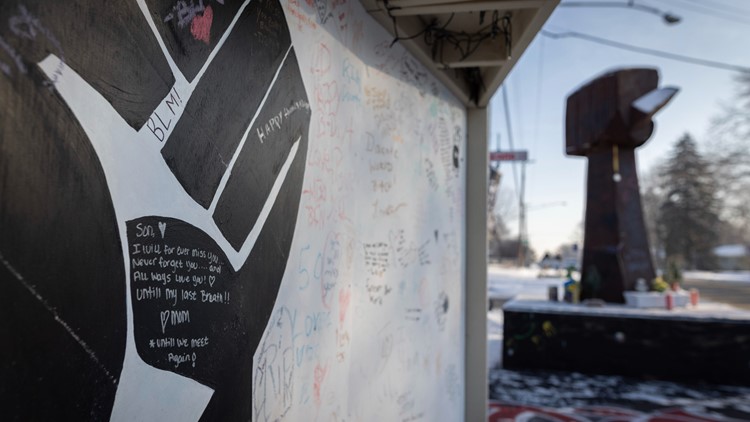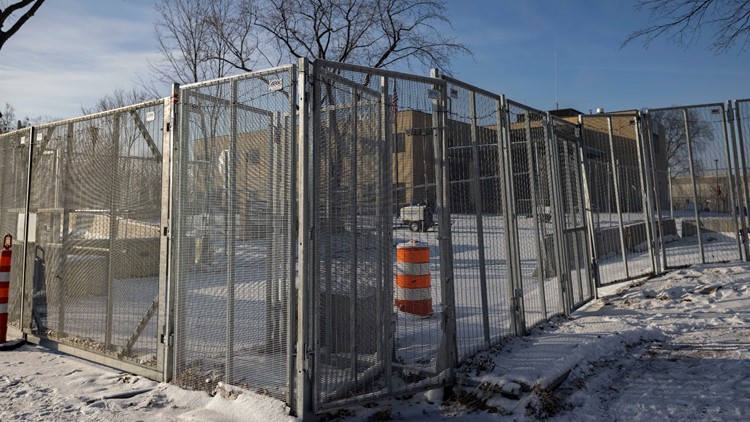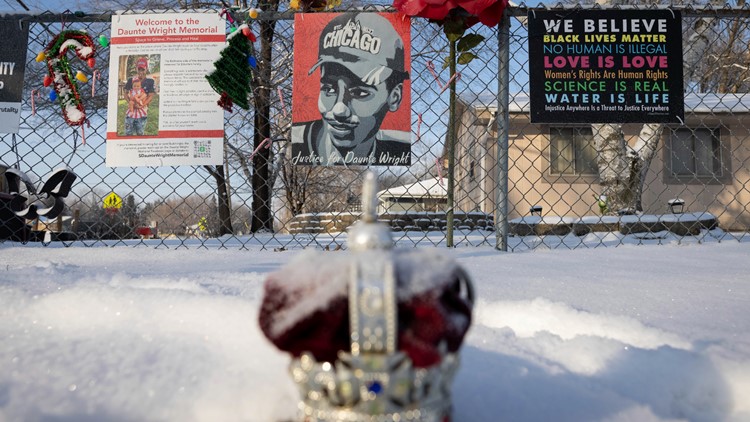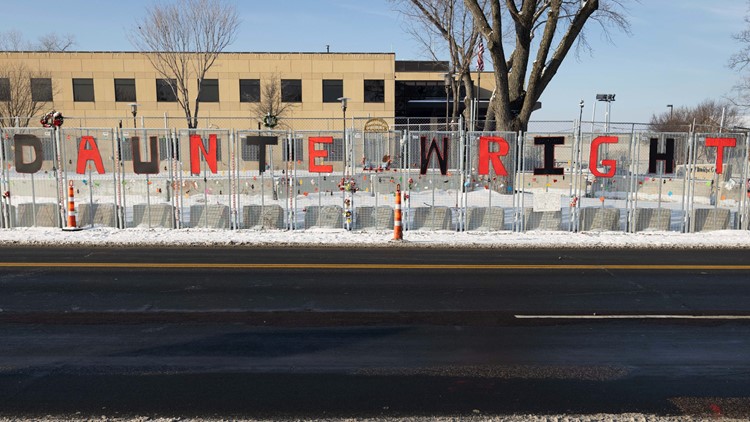MINNEAPOLIS —
- Asst. medical examiner talks jury through Daunte Wright's autopsy
- BCA forensic scientist describes evidence documented at scene of Wright's death
- BCA special agents discuss review of body camera and squad car dash cam footage, and the contents of Potter's duty belt at the time of Daunte Wright's death
The second week of the trial of Kim Potter, the former Brooklyn Center police officer charged with manslaughter in the April shooting death of Daunte Wright, began with Dr. Lorren Jackson, an assistant medical examiner for the Hennepin County Medical Examiner’s Office.
Jackson told the court he performed Wright’s autopsy on April 12, the day after he died. Although Jackson noted that Wright had “superficial” injuries to his face, arms and legs, he said the most significant injury present on Wright’s body was a gunshot wound to the chest. Jackson noted Wright’s other injuries appeared to be consistent with the car crash Wright was in after the shooting. He said the gunshot wound was not survivable and determined the manner of Wright’s death to be homicide.
Jackson also told the court that upon screening Wright’s blood, cannabinoids were found, indicating that he had ingested marijuana. Jackson told defense attorney Earl Gray that the quantified number of cannabinoids were on the “high end” of what he usually sees.
The prosecution followed Jackson’s testimony with people in various positions within the Minnesota Bureau of Criminal Apprehension (BCA). The first called to the stand was Melissa Loren, a forensic scientist who led the BCA’s response to the scene of Wright’s death, including collecting and documenting evidence.
On the stand, Loren identified several pieces of evidence she had collected on the day of Wright’s death, including photos of his car. Loren’s testimony was later complemented by that of BCA senior special agent Sam McGinnis, who told the court he, along with Loren, compared and contrasted Potter’s firearm and Taser in the days after Wright’s death.
McGinnis identified multiple differences between the two weapons, including color, grip, texture and safety functions. During cross examination, McGinnis agreed with defense attorney Paul Engh that the Taser Potter was carrying on April 11 was a new version that the police department had just purchased, but said its safety function was similar to previous versions.
The last witness Monday was Travis Melland, another forensic scientist with the BCA crime lab, who told the court he was asked to compare two items in the days following Wright’s death — a spent cartridge casing and a bullet — obtained by the BCA, and determine whether they were shot from a third item, a firearm.
Melland said after determining the characteristics were in line by examining them under the microscope, a further test firing confirmed they were from the same firearm.
After Melland's testimony, the prosecution told Judge Regina Chu it did not have any more witnesses to present Monday afternoon, prompting Chu to adjourn court for the day.
Testimony is scheduled to resume Tuesday at 9 a.m.
3:33 p.m.
The last witness for the prosecution Monday was Travis Melland with the BCA crime lab. He told Larson he was asked to compare two items — a spent cartridge casing and a bullet — obtained by the BCA, and determine whether they were shot from the third item, a firearm.
Melland said after determining the characteristics were in line by examining them under the microscope, a further test firing confirmed they were from the same firearm.
The defense declined to cross examine Melland.
As the prosecution declared they did not have more witnesses to present Monday afternoon, Judge Regina Chu announced court would adjourn early.
She reassured the jury that court is still on schedule, and Tuesday's proceedings would begin at 9 a.m.
3:17 p.m.
Court resumed after a short recess with Eric Koeppen, a forensic scientist in the biology division with the BCA.
Koeppen testified that he was tasked with examining and processing evidence for DNA profiling in the case. He confirmed to Larson that three of four sources of blood from within Wright's vehicle matched Wright's DNA profile.
Koeppen said the fourth blood sample that he tested was from an unknown woman. Koeppen said he was not given a DNA profile of Wright's girlfriend, Alayna Albrecht-Payton, for comparison.
The defense decided against cross examination and Koeppen was dismissed.
2 p.m.
BCA senior special agent Sam McGinnis told prosecutor Larson that after he briefly responded to the scene of the shooting, he gathered documentation including paperwork, witness interviews and reports from various officers.
He stated that a month later, on May 4, 2021, he met with police witnesses to obtain information from the Taser on Potter's duty belt. The report from the Taser showed that Potter was the only person who had had possession of the Taser and that it was functioning properly at the time of the incident. McGinnis agreed that it was the policy of the Brooklyn Center Police Department to have officers perform a function test before each shift, and that Potter had only performed the test on six of her last 10 shifts, with the last test performed on April 9.
Days later on May 6, McGinnis said he along with Loren and another BCA agent, compared several parts of both the firearm and Taser, identifying their differences. McGinnis noted different color, grips, textures and safety functions.
During cross examination by attorney Engh, McGinnis agreed the Taser that Potter was carrying the day of Wright's death was a new version that the police department had purchased in March. McGinnis then agreed that the Taser was designed so it could be held in a person's hands and had a trigger similar to a gun.
After a brief redirect by the prosecution, McGinnis said he was familiar with previous versions of the Taser Potter was carrying and that their safety switches are similar.
1:45 p.m.
After returning from lunch, the prosecution concluded its direct examination of BCA Special Agent Brent Peterson.
The defense then conducted a brief cross-examination. Defense attorney Earl Gray asked Peterson if visual observation is better than reviewing body camera footage, to which Peterson said yes.
On re-direct examination, Peterson clarified that reviewing body camera footage is still a critical part of his work, and there are often benefits to reviewing that footage rather than simply relying on eyewitness testimony.
12:30 p.m.
BCA Special Agent Brent Peterson was also called as a witness Monday.
Peterson testified that he has worked on around 73 use-of-force investigations with the BCA.
He said as part of his investigation into Wright’s death, he reviewed video of the traffic stop and subsequent shooting of Wright. He also said he reviewed video prepared for trial by the prosecution which synced footage from Potter and Sgt. Johnson’s body cameras with dash cam video from Officer Luckey’s squad car.
Peterson said during his review of that footage, he noted Potter’s behavior as they approached Wright’s vehicle to arrest him. He said it appeared to him that there was a “manipulation of her holster.”
“I’ve seen it before on other videos I’ve watched of officers,” Peterson said. “I myself have done that when I was on patrol. It just caught my attention.”
Peterson added that he carried same type of holster as Potter.
“It would be my practice at times when I was making a traffic stop to unlatch the first level of protection or safety on the holster just to, I guess, give myself a little of an advantage should I need to draw,” he said.
Peterson testified that he could can see the top of Sgt. Johnson's head in the body camera when the shot is fired. Last week, Sgt. Johnson testified that he was leaning into the car to hold the shift knob and ignition because he thought Wright might try and drive off when he pulled away during the arrest.
The court adjourned for lunch partway through the prosecution’s direct examination of Peterson. His testimony will resume at 1:30 p.m.
11:15 a.m.
The prosecution also called Melissa Loren, a forensic scientist with the Minnesota Bureau of Criminal Apprehension (BCA) to the stand Monday morning.
Loren testified that she is a crime scene team leader with the BCA, and leads teams of scientists at crime scenes as part of her job. She said she led the BCA’s response to the scene of Wright’s death, including collecting and documenting evidence.
The prosecution had Loren identify several pieces of evidence she collected, including pictures she took of Wright’s car on April 11. She also identified a discharged cartridge casing found in the front seat of the vehicle.
During cross-examination, Loren confirmed to defense attorney Paul Engh that she also found “plant material” in the car. She said she does not perform drug testing, but the physical appearance was “familiar” to her and she collected it.
10 a.m.
On Monday morning, the prosecution first called Dr. Lorren Jackson, an assistant medical examiner for the Hennepin County Medical Examiner's Office.
Dr. Jackson testified that he specializes in determining the cause and manner of death, particularly in “unusual, unexpected or violent” deaths. He conducted a field investigation at the scene of the crash where Daunte Wright’s body was recovered, and performed an autopsy the day after Wright’s death, on April 12.
Dr. Jackson said that in addition to the gunshot wound from the shooting, Wright had also suffered “superficial” injuries to his face along with bruises and abrasions on his arms and legs, which he said would be consistent with the car crash Wright was in after being shot. According to Dr. Jackson, the gunshot wound was the most “significant” injury.
He said the bullet entered the left side of Wright’s chest, and there appeared to be a partial exit wound on the right side. According to Jackson, though the bullet’s path was shallow in Wright’s chest, it crossed areas of his left lung, his heart and his right lung.
Dr. Jackson said that the injury was not survivable, with the survival time for such a wound being "seconds to minutes." He said he determined the cause of death was the gunshot wound, and the manner of death was determined to be a homicide, meaning “death at the hands of another.”
Dr. Jackson also said Wright’s blood was screened for drugs, and cannabinoids were the only substance found, indicating that Wright had ingested marijuana.
During cross-examination, defense attorney Earl Gray asked what the “quantified” amount of marijuana found was. Referring to his report, Jackson said the rate found was within a “normal” range of people who use marijuana, but that the numbers were on the ”high end” of numbers he sees.
Gray also asked Dr. Jackson if Wright could have driven off and been alive for up to a minute following the shooting. Dr. Jackson said that was “possible.”
In the first week of testimony, the court heard from Daunte Wright's mother and girlfriend, police and paramedics called to the scene of the shooting, and the Brooklyn Center officer training with Kim Potter on April 1, 2021, the day Daunte Wright was fatally shot.
On Monday, a medical examiner is expected to take the stand to talk the jury through the details of Wright's autopsy.
On Friday, court was cut short by heavy snow, but before dismissal, prosecutors called Major Mychal Johnson of the Goodhue County Sheriff's Office to the witness stand.
Johnson, who was a Brooklyn Center police officer in April 2021, told jurors he responded to a call for backup from officer Anthony Luckey, who was riding in the squad with Potter, to assist with a traffic stop.
He detailed what he saw at the scene, including Wright's arrest. Johnson heard a pop, which he thought was Potter firing her Taser, but it was the sound of Potter shooting Wright. Shortly after, he said he took Potter's firearm. She was then placed in the back of a police car, and he took his weapon back while keeping hers to give to the BCA as evidence.
Following a break for lunch, former commander and now acting Brooklyn Center Police Chief Tony Gruenig was called to the stand by prosecutors. He was tasked with explaining the structure of the department and his role in responding to the scene of the traffic stop where Daunte Wright was shot.
BCA Special Agent Michael Phill was the final witness called by the prosecution on Friday. Assistant Hennepin County Attorney Josh Larson queried Phill about how he arrived in Brooklyn Center with his team to take over the crime scene, and how evidence was collected and brought back to BCA labs for analysis. Phill described seeing Wright's body laying out in the open, and told the court he ordered a tent put up over it.
Kim Potter faces one count of first degree manslaughter and one count of second degree manslaughter for the death of Daunte Wright.
Testimony is expected to resume Monday morning at 9 a.m.

